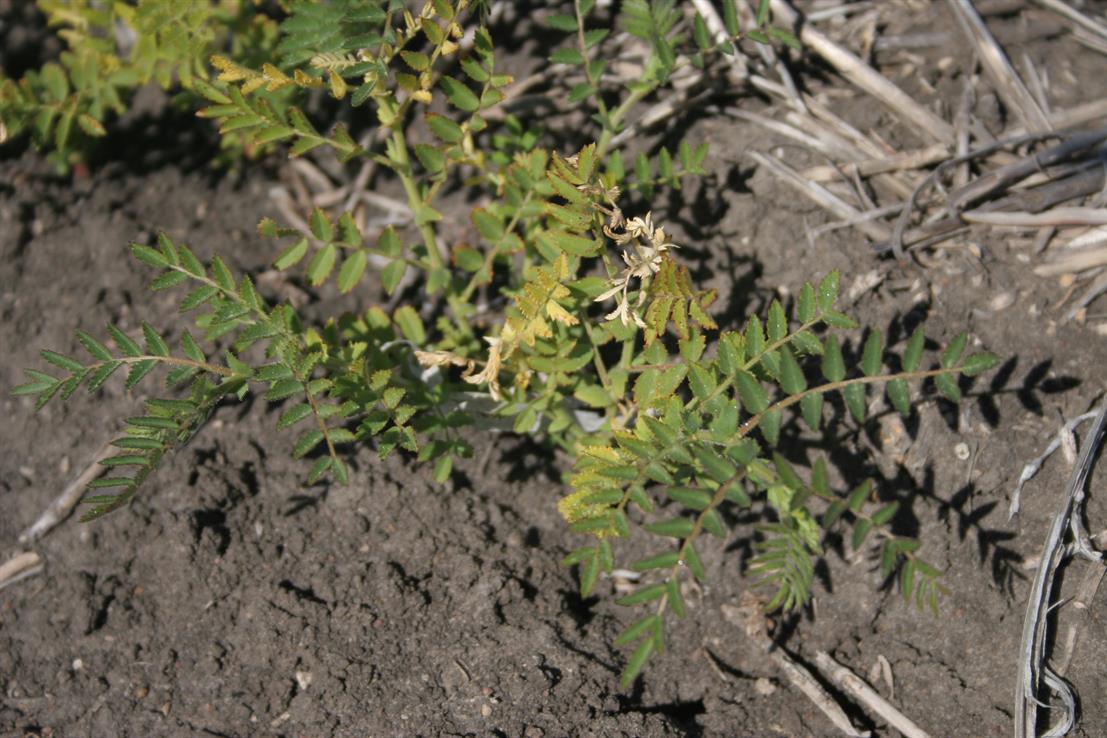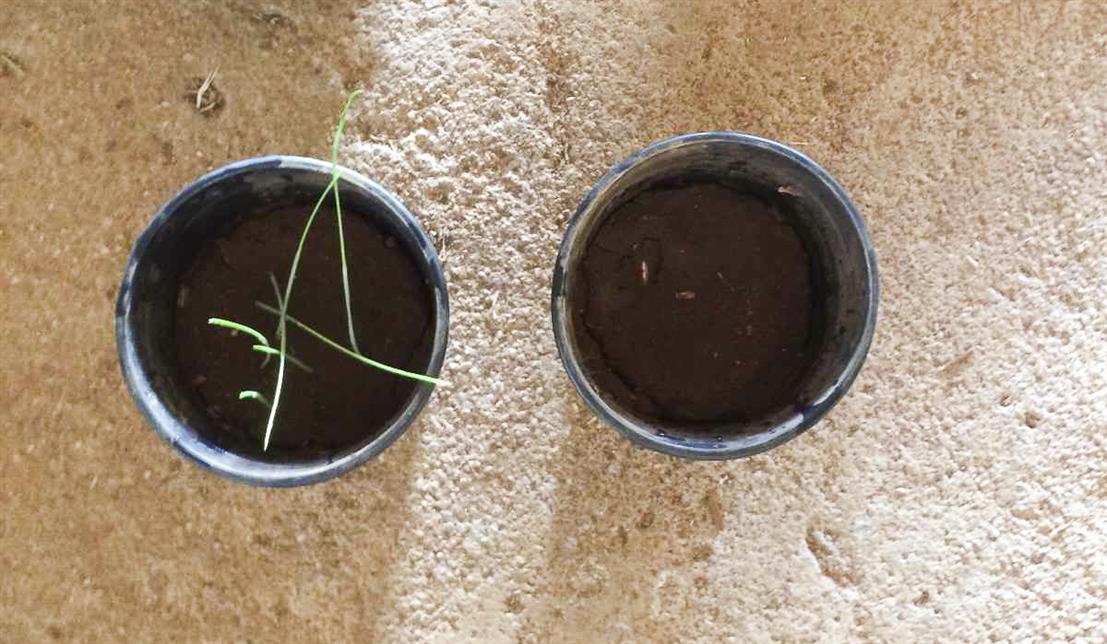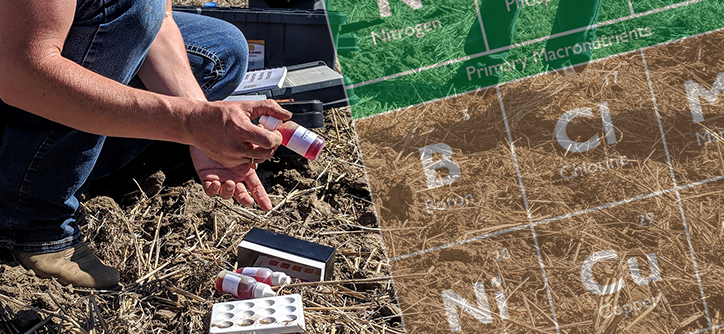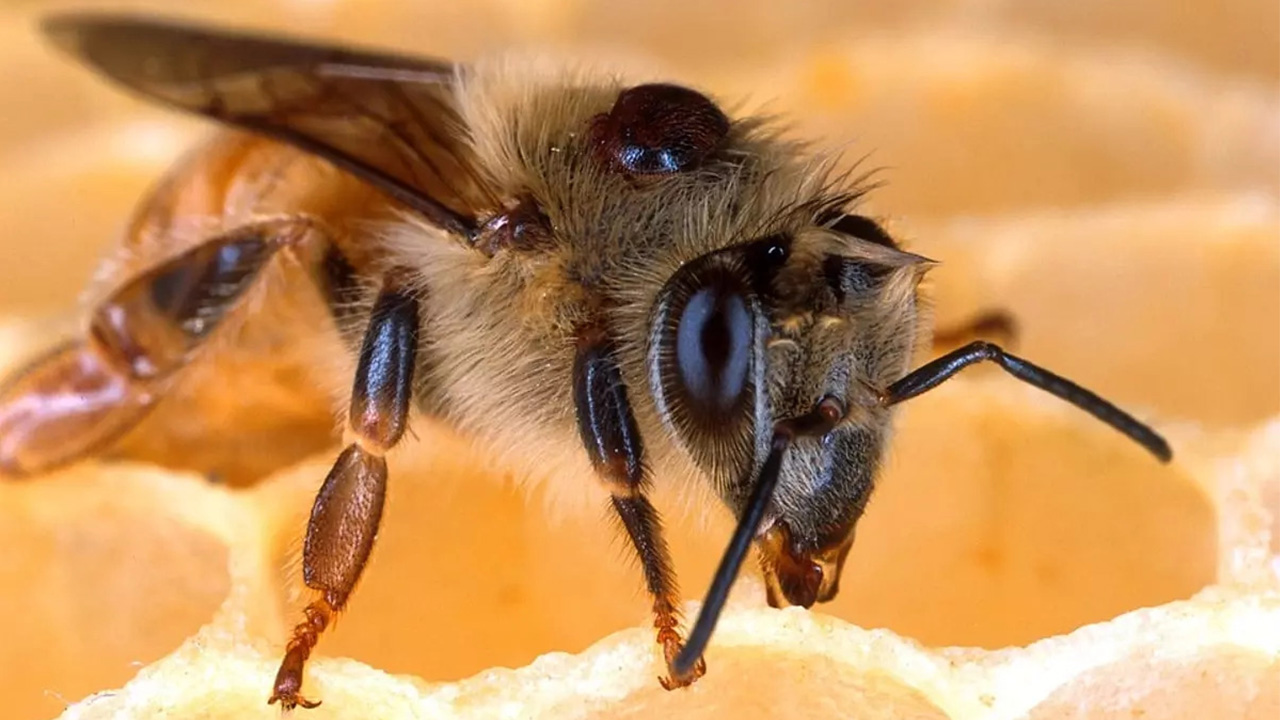With the growing resistance to post emergent herbicides in many weed populations the message going to farmers is that they need to use more pre-emergent herbicides in their farming system.
The problem with pre-emergent herbicides is that they are dependent on activation by soil moisture. Droughts and increasingly variable rainfall patterns can result in insufficient soil moisture to activate the herbicide which leads to poor weed control. The other concern is that herbicides remain active in the soil because they have not been broken down by bacterial activity or hydrolysis.
In many parts of the country, the 2018 winter crop season saw large areas of crop damaged by soil herbicide residues, due to the dry conditions between spraying in 2017 and crop emergence in 2018.

Chickpeas absorbing Group B herbicide from deeper in the soil, Tulloona, NSW. Image: AGRONOMO
The level of herbicide remaining in the soil will be determined by:
- initial application rate and herbicide type
- soil pH – most herbicides last longer in alkaline soils while Group B imidazolinones become more water soluble and can move down the soil profile
- the amount of rainfall received between application and sowing
- soil temperature – warm, damp soil speeds herbicide breakdown
- soil texture, that is, the proportion of clay to sand and silt – sandy soils are more likely to have herbicide damage problems than clay soils
- amount of cultivation – cultivation usually speeds herbicide loss and can dilute it by soil mixing
- crop type and variety
- soil organic matter content – high soil organic matter levels reduce the effect of soil active herbicides. However most Australian soils are classed as low in organic matter
- microbial activity for some herbicides – most of the above factors affect microbial activity
As can be seen from the factors which affect herbicide persistence in the soil, and many of these are out of the farmer’s control.
Most labels will give crop plant back periods based on the amount of rain received since application, soil characteristics and herbicide rate. If you are on the borderline for these characteristics can you safely sow the next crop?
HOW TO DETERMINE IF RESIDUES ARE PRESENT
1. Susceptible weeds damaged or dying
If there are weeds susceptible to the herbicide present and they show no damage symptoms, it is likely there are no damaging herbicide residues.
However, care must be taken to check whether the particular weeds have not germinated from below or above the possible herbicide band. This prevents weeds absorbing herbicide.
If it hasn’t rained, you will be none the wiser.
2. Laboratory testing
Laboratory soil testing will cost approximately over $400 per herbicide group and the herbicides to be tested must be specified. The technique most often used is the Gas-Liquid Mass Spectrometer.
Laboratory testing can tell how much herbicide is remaining, however most farmers will not need this level of detail.
3. Pot Test (Bioassay)
The simple pot test outlined here does not give an exact measure of the amount of residue present but does indicate whether there is enough herbicide remaining to damage sensitive crops.
The test will take at least 3-4 weeks to perform, so forward planning is essential if sowing and marketing windows are not to be put at risk.
The ‘pot test’ was developed by the late KP Buchholtz for testing of atrazine residues, however it can be used for most soil active herbicides.
- 1. Take samples from several locations around the field. Remember that a test is only as good as the sample collected. Sample enough areas to prevent missing any possible high residue areas such as headlands. It may be useful to take separate samples from areas you suspect of being abnormally high. Take samples to the normal cultivation depth, or to 10 cm in non-cultivated fields. It is advisable to take samples from deeper in the profile as well if you have used a highly water-soluble herbicide.
Collect about 5 kg per test. - 2. If samples can’t be tested within two weeks of sampling, freeze them. Allowing samples to get hot can reduce the amount of herbicide residue present.
- 3. Air dry samples that are wet by spreading out on a tarp. Cloddy soils should be crushed to produce even, pea-sized clods.
- 4. Heavy-textured (clay) soils can be improved by adding an equal quantity of clean sand and then mixing thoroughly when dry.
- 5. Add the contents of two capsules (0.5 g) of activated carbon (powdered charcoal) to half the soil or sand-soil, mixing thoroughly. The carbon inactivates (binds) the herbicide. Soil treated with carbon should behave in the same manner as soil which contains no herbicide residues. Activated carbon is readily available from pharmacies.
- 6. Partially fill two 1-litre containers with soil, but without the carbon and the two containers with the soil-carbon mix. Plant pots or ice cream and drink containers with drainage holes in the base can be used.
- 7. Plant about 15 seeds of the crop in question and a known-sensitive species (see Table 1) in each container and cover the seeds with 1-2 cm of soil and lightly water.
- 8. Place the containers in a warm place (20-24 o C) where they will get plenty of sunlight. Sunlight is necessary for many herbicide symptoms to develop.
- 9. Symptoms should appear within 2-4 weeks of planting. Plants in pots exposed to lower temperatures will take longer to show symptoms.
- 10. If there are differences in growth between the soil with carbon and soil without carbon pots, it is advisable to only sow crops tolerant of the herbicide in question or go to a fallow.
 Pot test using oats as the test species to check for Group C (terbuthylazine) and Group D (propyzamide) residues in 2018 after they were applied to a lupin crop in 2017. Very dry conditions in 2017-18 meant there was sufficient herbicide remaining to damage a cereal crop. Left pot has the carbon added. Image: C. Roche
Pot test using oats as the test species to check for Group C (terbuthylazine) and Group D (propyzamide) residues in 2018 after they were applied to a lupin crop in 2017. Very dry conditions in 2017-18 meant there was sufficient herbicide remaining to damage a cereal crop. Left pot has the carbon added. Image: C. Roche
The following table is a useful guide to species sensitive to the main herbicide groups and typical symptoms to look for.
Table 1 Indicator plants and symptoms for diagnosing herbicide residues
| Herbicides by MOA Group | Indicator Plants | General Symptoms |
| B chlorsulfuron, triasulfuron, metsulfuron, sulfometuron imazamox, imazapic, imazapyr florasulam, flumetsulam, pyroxulam |
|
Stunting, yellowing of new growth, particularly between the leaf veins. “Onion-leafing” and reduced tillering in cereals. Leaf-cupping in legumes |
| C diuron, atrazine, cyanazine, simazine, terbuthylazine, terbutryn fluometuron hexazinone, metribuzin |
|
Stunting of growth – yellowing of leaves between veins, often leading to browning/death starting at leaf margins. Faba beans show blackening of leaves, particularly around margins. |
| D trifluralin, oryzalin, pendimethalin propyzamide |
|
Reduced emergence. Stunted growth, thickening of roots with little or no secondary root development. Trifluralin causes crinkling of leaves and pendimethalin gives rounded tips in grasses. |
| F norflurazon diflufenican, picolinafen |
|
Emerging plants yellow and then develop patches of white/mauve-pink discolouration. Lupins and lentils show temporary yellow or white banding on leaves. |
| G oxyfluorfen flumioxazin pyraflufen saflufenacil carfentrazone |
|
Rapid yellowing of newly emergedcotyledons and first leaves followed by death. |
| H isoxaflutole pyrasulfotole |
|
Rapid yellowing followed by irregular patches of white and/or mauve–pink discoloration. The yellowing spreads and the plants become necrotic and die. |
| I aminopyralid, clopyralid, picloram 2,4-D dicamba halauxifen |
|
“Onion-leafing”, reduced tillering and stunting in cereals. Twisting and distorted leaf development such as “strapping” and “cupping”. Increased development of fibrous roots. |
| K dimethenamid, metazachlor, metolachlor pyroxasulfone |
|
Seedlings usually fail to emerge from the soil. Cell elongation slows quickly. Susceptible monocots that do emerge appeared twisted and malformed with leaves tightly rolled in a whorl. Broadleaf seedlings may have enlarged cotyledons, slightly cupped or crinkled leaves and shortened leaf midribs causing the leaf to look like the mid-vein has been drawn back towards the stem. Leaf colour can be very dark green. |
| Q amitrole clomazone |
|
Rapid bleaching of seedlings followed by necrosis. |
Andrew Storrie, AGRONOMO




